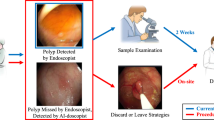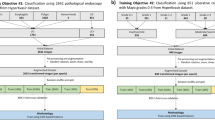Abstract
Research on learning automatically medical image descriptors requires very large sample training data along with complex deep learning neural networks models. This is a challenging requirement for many medical specialties. However, new research trends indicate that Siamese neural network can be trained with small samples and still provide acceptable accuracy, but this yet to be demonstrated for medical practices like identifying ulcerative colitis severity in video colonoscopy. In this research paper, we are introducing a Siamese neural model that uses triplet loss function that enables the gastroenterologist inject anchor images that can correctly identify the ulcerative colitis severity classes and we are using for this purpose the Mayo Clinic Ulcerative Colitis Endoscopic Scoring scale. The Python prototype demonstrates performance accuracy of 70% in average by only training the model with one video of 75 frames along with 24 anchor images. This research is part of our ongoing effort to employ more thick data techniques for enhancing the accuracy and interpretations of deep learning analytics by incorporating more heuristics from the experts. We are following this attempt by other validation methods including the YOLO visual annotation and additive image augmentations.
Access this chapter
Tax calculation will be finalised at checkout
Purchases are for personal use only
Similar content being viewed by others
References
Yamada, M., et al.: Development of a real-time endoscopic image diagnosis support system using deep learning technology in colonoscopy. Sci. Rep. 9(1), 14465 (2019)
Fu, Z., et al.: The future of endoscopic navigation: a review of advanced endoscopic vision technology. IEEE Access 9, 41144–41167 (2021)
Xiaobei, L., et al.: Artificial intelligence− enhanced white-light colonoscopy with attention guidance predicts colorectal cancer invasion depth. Gastrointest. Endosc. 94(3), 627–638.e1 (2021)
Hassan, C., et al.: New artificial intelligence system: first validation study versus experienced endoscopists for colorectal polyp detection. Gut 69(5), 799–800 (2020)
Guo, X., Zhang, N., Guo, J., Zhang, H., Hao, Y., Hang, J.: Automated polyp segmentation for colonoscopy images: a method based on convolutional neural networks and ensemble learning. Med. Phys. 46(12), 5666–5676 (2019)
Li, K., et al.: Colonoscopy polyp detection and classification: dataset creation and comparative evaluations. PLOS ONE 16(8), e0255809 (2021)
Urban, G., et al.: Deep learning localizes and identifies polyps in real time with 96% accuracy in screening colonoscopy. Gastroenterology 155(4), 1069–1078 (2018)
Yang, Y.J., et al.: Automated classification of colorectal neoplasms in white-light colonoscopy images via deep learning. J. Clin. Med. 9(5), 1593 (2020)
Medela, A., et al.: Few shot learning in histopathological images: reducing the need of labeled data on biological datasets. In: 2019 IEEE 16th International Symposium on Biomedical Imaging (ISBI 2019), pp. 1860–1864. IEEE (2019)
Finn, C., Abbeel, P., Levine, S.: Model-agnostic meta-learning for fast adaptation of deep networks. In: International Conference on Machine Learning, PMLR, pp. 1126–1135. (2017)
Srinivasan, A., Bharadwaj, A., Sathyan, M., Natarajan, S.: Optimization of image embeddings for few shot learning. arXiv preprint arXiv:2004.02034 (2020)
Jadon, S.: An overview of deep learning architectures in few-shot learning domain. arXiv preprint arXiv:2008.06365 (2020)
Fiaidhi, J., Zezos, P., Mohammed, S.: Thick data analytics for rating ulcerative colitis severity using small endoscopy image sample. In: IEEE Big Data 2021 Conference 15–19 Dec 2021
Du, J.: Understanding of object detection based on CNN family and YOLO. J. Phys.: Conf. Ser. 1004(1), 012029 (2018)
Sharara, A.I., Malaeb, M., Lenfant, M., Ferrante, M.: Assessment of endoscopic disease activity in ulcerative colitis: is simplicity the ultimate sophistication? Inflamm. Intest. Dis. 7(1), 7–12 (2022)
Hoffer, E., Ailon, N.: Deep metric learning using triplet network. In: Feragen, A., Pelillo, M., Loog, M. (eds.) SIMBAD 2015. LNCS, vol. 9370, pp. 84–92. Springer, Cham (2015). https://doi.org/10.1007/978-3-319-24261-3_7
Pogorelov, K., et al.: Kvasir: A multi-class image dataset for computer aided gastrointestinal disease detection. In: Proceedings of the 8th ACM on Multimedia Systems Conference, pp. 164–169 (2017)
Anton, M.: TrainYourOwnYOLO: Building a Custom Object Detector from Scratch, Github Repo. https://github.com/AntonMu/TrainYourOwnYOLO (2019)
Sawyer, D., Fiaidhi, J., Mohammed, S.: Few shot learning of covid-19 classification based on sequential and pretrained models: a thick data approach. In: 2021 IEEE 45th Annual Computers, Software, and Applications Conference (COMPSAC), pp. 1832–1836. IEEE (2021)
Heidari, M., Fouladi-Ghaleh, K.: Using Siamese Networks with Transfer Learning for Face Recognition on Small-Samples Datasets. In: 2020 International Conference on Machine Vision and Image Processing (MVIP), pp. 1–4. IEEE (2020)
Acknowledgments
This research is funded by the first author NSERC DDG- DDG-2020–00037 and first and second author MITACS Accelerates Grant IT22305 of 2021.
Author information
Authors and Affiliations
Corresponding author
Editor information
Editors and Affiliations
Rights and permissions
Copyright information
© 2023 The Author(s), under exclusive license to Springer Nature Switzerland AG
About this paper
Cite this paper
Fiaidhi, J., Mohammed, S., Zezos, P. (2023). Siamese Neural Network for Labeling Severity of Ulcerative Colitis Video Colonoscopy: A Thick Data Approach. In: Arai, K. (eds) Intelligent Systems and Applications. IntelliSys 2022. Lecture Notes in Networks and Systems, vol 542. Springer, Cham. https://doi.org/10.1007/978-3-031-16072-1_9
Download citation
DOI: https://doi.org/10.1007/978-3-031-16072-1_9
Published:
Publisher Name: Springer, Cham
Print ISBN: 978-3-031-16071-4
Online ISBN: 978-3-031-16072-1
eBook Packages: Intelligent Technologies and RoboticsIntelligent Technologies and Robotics (R0)




